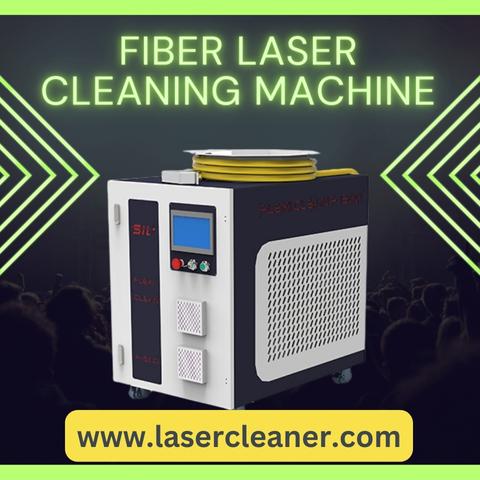A fiber laser cleaning machine is a specialized tool that uses concentrated laser beams to remove contaminants, rust, coatings, and impurities from surfaces without damaging the base material. In industries where precision, safety, and efficiency are critical, this technology has become one of the most trusted solutions for surface treatment. Unlike traditional cleaning methods such as sandblasting or chemical washing, a fiber laser cleaning machine operates with pinpoint accuracy and eliminates the need for abrasive media or harmful solvents.
The development of fiber laser cleaning technology was driven by the demand for an environmentally safe and highly efficient cleaning process. Manufacturers, automotive companies, aerospace operators, and even small workshops are now using this technology to restore, maintain, and prepare metal and non-metallic surfaces for further operations. The laser beam targets unwanted layers and vaporizes or detaches them, leaving behind a clean and prepared surface ready for painting, coating, welding, or further treatment.
In this guide, we will dive into every aspect of the fiber laser cleaning machine, including its operation, industrial applications, working process, safety aspects, and why it has gained significant attention across various sectors.
How a Fiber Laser Cleaning Machine Works
The operation of a fiber laser cleaning machine is based on the principle of laser ablation. A laser beam with a specific wavelength is directed onto the surface that needs to be cleaned. The beam energy interacts with the contaminants or oxides, causing them to either vaporize or separate from the surface. The machine allows precise control of beam intensity, frequency, and focus to ensure that only the undesired material is removed while the substrate remains untouched.
Fiber lasers use optical fibers doped with rare-earth elements to amplify light, creating a stable and high-powered laser beam. The flexibility of fiber delivery makes it easier to maneuver the machine over complex shapes, corners, or delicate areas. This controlled process is non-contact, meaning no physical abrasion occurs, which reduces wear on tools and prolongs equipment life.
Industrial Applications of Fiber Laser Cleaning Machines
Fiber laser cleaning machines have found widespread use across industries because of their adaptability. Some key application areas include:
-
Automotive Industry: Used for removing paint, rust, and oxides from car parts, frames, and molds before welding or repainting.
-
Aerospace: Cleaning aircraft components where precision is vital, such as turbine blades and landing gear parts.
-
Electronics Manufacturing: Used to clean delicate surfaces or connectors without causing mechanical damage.
-
Power Generation: Effective for cleaning turbines, boilers, and pipelines that often face rust or corrosion.
-
Cultural Heritage Preservation: Safely removes dirt, pollution layers, and biological growth from monuments, sculptures, and historical buildings.
-
Shipbuilding and Marine Sector: Used for cleaning hulls, removing rust, and maintaining offshore equipment.
This versatility is a major reason why companies across different sectors are adopting fiber laser cleaning machines as a long-term solution.
Benefits for Surface Preparation
When industries prepare materials for coating, welding, or bonding, surface cleanliness plays a crucial role. A fiber laser cleaning machine ensures the removal of oils, oxides, or impurities, which can otherwise weaken the quality of welds or coatings. By providing a clean base surface, the process increases adhesion, durability, and performance of the treated material.
Additionally, fiber laser cleaning is a dry process that requires no consumables such as sand, chemicals, or water. This not only reduces operational costs but also simplifies logistics and storage.
Safety Aspects of Fiber Laser Cleaning
The fiber laser cleaning machine is designed with safety considerations in mind. Operators typically wear protective eyewear to guard against laser radiation. The non-contact nature of the cleaning process reduces physical risks, as there is no direct handling of abrasive or chemical substances. Many machines come with enclosures, ventilation systems, or dust extractors that ensure safe use in industrial environments.
When used correctly, fiber laser cleaning machines are safer than many traditional cleaning methods. They eliminate harmful fumes associated with chemicals and avoid airborne abrasive particles common with sandblasting.
Environmental Considerations
Sustainability is a growing priority for industries worldwide, and the fiber laser cleaning machine directly supports this shift. Since it uses only light energy, the process produces minimal waste compared to methods involving solvents or blasting materials. Contaminants removed by the laser are usually collected in filtration systems, preventing environmental release.
This eco-friendly approach allows businesses to meet strict environmental regulations without compromising efficiency. It also reduces the need for costly waste treatment or chemical disposal systems.
Cost Efficiency and Productivity
The long-term value of a fiber laser cleaning machine comes from its ability to reduce operational costs while boosting productivity. Traditional cleaning often requires consumables, frequent replacements, and manual labor. In contrast, laser cleaning is automated, precise, and requires minimal maintenance. The reduced downtime and faster processing speed allow industries to save both time and resources.
Moreover, the durability of fiber laser sources means these machines have long lifespans, making them a sound investment for manufacturers aiming for consistent performance over years of operation.
Fiber Laser Cleaning in Modern Manufacturing
Modern manufacturing demands speed, flexibility, and consistent quality. Fiber laser cleaning machines have become an integral part of smart factories and automated production lines. Their compatibility with robotic arms and CNC systems makes them adaptable for mass production environments.
By integrating these machines into production workflows, manufacturers can achieve repeatable results with minimal human intervention. This not only improves quality but also allows workers to focus on higher-value tasks instead of repetitive cleaning operations.
Maintenance of Fiber Laser Cleaning Machines
Regular maintenance ensures that the fiber laser cleaning machine delivers optimal performance over time. While these machines are designed to be robust and durable, periodic inspection of optics, cooling systems, and laser sources is recommended. Dust extractors and filters must also be cleaned or replaced at intervals to maintain safety and efficiency.
Unlike mechanical cleaning devices, the maintenance requirements here are minimal, which contributes to the overall cost-effectiveness of the technology.
Future of Fiber Laser Cleaning Technology
As industries continue to evolve, the demand for advanced surface treatment methods is growing. Fiber laser cleaning machines are expected to become even more common, with improvements in beam delivery, automation, and energy efficiency. Research is ongoing to expand their application range, including cleaning composite materials and delicate surfaces in medical devices.
The shift towards greener technologies and stricter environmental compliance is likely to further accelerate the adoption of fiber laser cleaning machines worldwide.
Final Thoughts
The fiber laser cleaning machine is more than just a replacement for traditional cleaning methods; it represents the future of surface treatment. Its ability to provide precise, efficient, and environmentally safe cleaning has already transformed multiple industries, from automotive to aerospace. By eliminating the need for consumables, reducing risks, and delivering consistent results, it has become an essential tool for modern manufacturing and maintenance operations.

